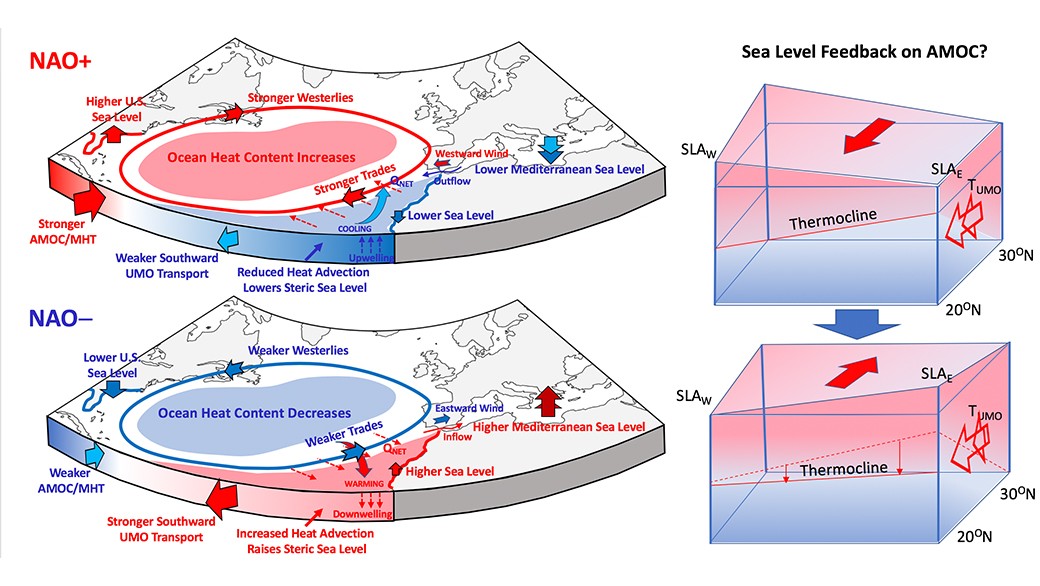AOML scientists are currently studying the effect of the Atlantic Meridional Overturning Circulation (AMOC) on coastal sea level variations. The results show that the AMOC routinely measured from mooring spread across the North Atlantic 26.5ºN latitude drives the basin-scale sea level changes that ultimately translate to coastal sea level changes along the US East Coast, the Northwest Coast of Africa, and in the Mediterranean Sea. This link allows a more nuanced understanding of coastal sea level on either side of the Atlantic.
The global mean sea level rise caused by ocean warming and glacier melting over landforms such as Greenland is one of the most alarming aspects of a shifting global climate. However, the dynamics of the ocean and atmosphere further influence sea level changes region by region and over time. For example, along the U.S. East Coast, a pronounced acceleration of sea level rise in 2010-2015 was observed south of Cape Hatteras, while a deceleration occurred up North. These patterns provide background conditions, on top of which shorter-period (and often stronger) weather-driven sea level fluctuations compound what coastal communities directly experience day by day. Therefore, to develop or improve regional sea level predictions, it’s important to identify these patterns and explore how they change over time.
AOML scientists have looked at the AMOC observations at 26.5N to understand its role in shaping the regional patterns of sea level change in the North Atlantic. A stronger than the average AMOC carries more heat northward and, therefore, leads to ocean warming in the North Atlantic and cooling in the tropics. Warming and cooling of the ocean is associated with rising and falling sea levels (warmer water expands and cooler water contracts, a process called thermal expansion). This AMOC-driven redistribution of heat in the ocean creates a characteristic ocean pattern of year-to-year and longer-term sea level changes. This pattern can translate to coastal sea level changes along the U.S. East Coast and the northwest coast of Africa and in the Mediterranean Sea. For example, warmer water over the deep ocean expands, takes up more space, and pushes water towards the shore.
From 2010-2015, warming of the Gulf Stream led to accelerated sea level rise south of Cape Hatteras. On the other side of the Atlantic, the record-high sea level observed in the Mediterranean in 2010 was also partially caused by the large-scale AMOC-driven redistribution of heat in the North Atlantic.

Scientists hypothesize that the AMOC-driven sea level changes along the western and eastern boundaries of the North Atlantic can create a feedback on the AMOC strength. Higher sea level along the U.S. East Coast and lower sea level along the West Coast of Africa tend to slowdown the AMOC, while the opposite situation favors its intensification.
Studying these shifting mechanisms help scientists understand how opposite coasts are affected by changes in the AMOC simultaneously. Because sea level responds to changes in the AMOC with a time lag, there is a potential for multi-year predictability of coastal sea level using available observations of the AMOC, which would help keeping our coastal communities prepared and informed, lessening risk to lives and to property.
See the full publication here: Volkov, D. L., Baringer, M., Smeed, D., Johns, W., & Landerer, F. W. (2019). Teleconnection between the Atlantic Meridional Overturning Circulation and sea level in the Mediterranean Sea. Journal of Climate, 32(3), 935-955.
Note: Parts of this study have been published in Journal of Climate and Geophysical Research Letters. To read those sections, visit the links below:
https://journals.ametsoc.org/doi/full/10.1175/JCLI-D-18-0474.1
https://agupubs.onlinelibrary.wiley.com/doi/full/10.1029/2018GL081183
